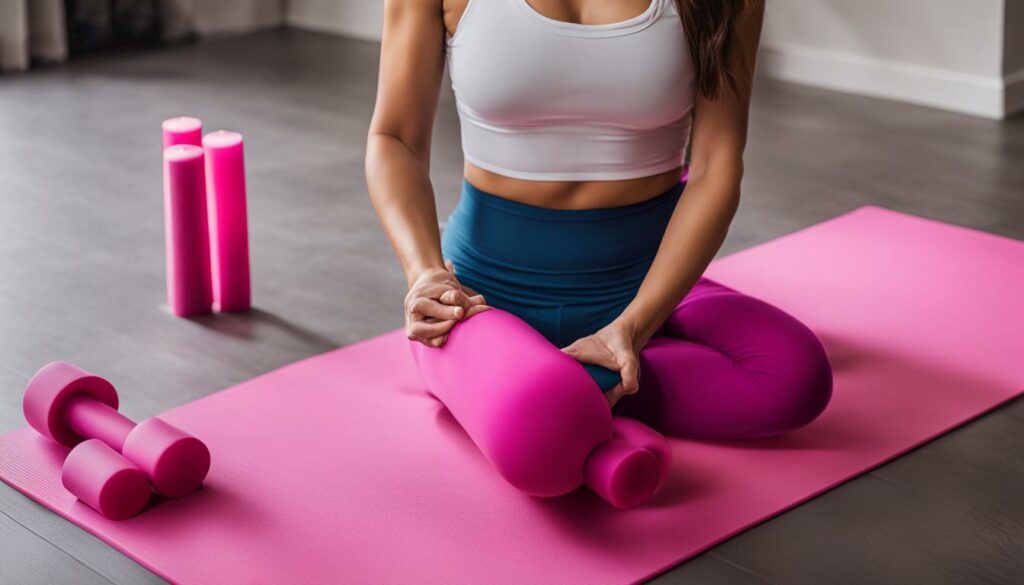Kegel exercises, also known as pelvic floor exercises, are a simple yet effective workout routine that can significantly enhance sexual performance. The pelvic floor muscles play a crucial role in arousal, pleasure, and orgasm response.
Strengthening these muscles through specific exercises, such as kegels, has been shown to improve sexual satisfaction in both men and women. Additionally, using Kegel weights or devices can provide added resistance and accelerate the strengthening process.
In this article, we will explore the benefits of kegel exercises and provide a step-by-step guide on how to perform them.
Key Takeaways:
- Kegel exercises strengthen the pelvic floor muscles, enhancing sexual performance and satisfaction.
- Both men and women can benefit from incorporating kegel exercises into their routine.
- Using kegel weights or devices can further enhance the effectiveness of the exercises.
- Proper technique and consistency are crucial for maximizing the benefits of kegel exercises.
- Kegel exercises offer additional advantages such as improved bladder control and reduced risk of pelvic organ prolapse.
How to Perform Basic Kegel Exercises
Performing basic kegel exercises correctly is essential to maximize their effectiveness. To begin, imagine that your urethra is a telescope and visualize pulling it up and into your body.
Avoid contracting your buttocks or pulling your abdominals in too tightly during the exercise. It’s crucial to maintain proper breathing during kegels, as holding your breath can lead to pressure on the bladder and pelvic floor.
- Step 1: Start by inhaling and relaxing.
- Step 2: Exhale as if blowing out birthday candles while simultaneously contracting the pelvic floor muscles.
- Step 3: Hold the contraction for 5 seconds.
- Step 4: Relax for 5 seconds.
Repeat this sequence 10 times and aim to progress the hold time from 5 to 10 seconds with each repetition. By practicing these basic kegel exercises regularly, you can strengthen your pelvic floor muscles and enhance their overall function.
Remember to consult with a healthcare professional for guidance on proper technique and progression.

Proper Technique for Basic Kegel Exercises
“Imagine your urethra is a telescope and visualize pulling it up and into your body. Avoid contracting your buttocks or pulling your abdominals in too tightly during the exercise.”
Progressing with Kegel Resistance Devices
Once you have mastered basic kegel exercises, it’s time to take your pelvic floor strength to the next level. Incorporating kegel resistance devices, such as vaginal weights, can further enhance the effectiveness of your kegel routine.
Adding resistance to your kegel exercises challenges your pelvic floor muscles and promotes stronger contractions. Vaginal weights are specially designed devices that come in different sizes and weights to provide progressive resistance.
To start using vaginal weights, begin by inserting a white weight of your choice into your vagina. Try to hold the weight inside for one minute while maintaining a strong contraction of your pelvic floor muscles.
If this can be achieved easily, you can gradually increase the weight and duration to continue challenging your pelvic floor muscles.
Here is a suggested progression guide:
- Use a white vaginal weight and aim to hold it inside for one minute.
- If one minute becomes too easy, increase the weight and attempt to hold it for a longer duration.
- Once you have built sufficient strength, you can try activities like walking while wearing the inserted weight for around 20 minutes.
- Repeat these exercises 3-5 days per week to see continuous improvement in your pelvic floor strength.
As you progress with your kegel exercises, you can incorporate different positions and movements to further challenge your pelvic floor muscles. Here are a few examples:
- Standing Kegels: In a standing position, contract and relax your pelvic floor muscles while maintaining good posture.
- Standing Heel Raise Kegels: From a standing position, rise up onto the balls of your feet while contracting your pelvic floor muscles. Lower yourself back down and release the contraction.
- Mini Squat Kegels: Stand with your feet shoulder-width apart and perform a gentle squat while contracting your pelvic floor muscles. Return to the starting position and release the contraction.
Remember to listen to your body and progress at your own pace. It’s normal to feel some muscle fatigue, but you should not experience any pain or discomfort. If you have any concerns or questions, consult with a healthcare professional for guidance and support.

Kegel Exercises for Erectile Dysfunction and Premature Ejaculation
Kegel exercises are not limited to women; they can also benefit men, especially those experiencing erectile dysfunction or premature ejaculation.
Strengthening the pelvic floor muscles, including the ischiocavernosus and bulbocavernosus muscles, can assist the penis in obtaining and maintaining an erection, as well as address issues that cause premature ejaculation.
Men can perform floor lying, side lying, and sitting kegel exercises to target these muscles. It is important to do the exercises correctly to avoid straining and to gradually increase the duration and intensity of the squeezes over time.
The Importance of Kegel Exercises for Men
Erectile dysfunction is a common condition in men, characterized by the inability to achieve or maintain an erection. It can have various causes, including poor blood flow to the penis and weak pelvic floor muscles.
Kegel exercises can help improve blood circulation to the pelvic region and strengthen the muscles responsible for erection, leading to improved sexual function.
“Regular kegel exercises can significantly improve erectile dysfunction by enhancing blood flow and strengthening the pelvic floor muscles.”
Premature ejaculation refers to the condition where a man ejaculates uncontrollably and prematurely during sexual activity. Weak pelvic floor muscles can contribute to premature ejaculation by reducing control over ejaculation.
By strengthening the pelvic floor muscles through kegel exercises, men can gain better control and delay ejaculation, enhancing sexual pleasure for both partners.
Performing Kegel Exercises for Men
To perform kegel exercises for men, follow these simple steps:
- Identify the pelvic floor muscles: The easiest way to identify the pelvic floor muscles is by stopping the flow of urine midstream. The muscles used to stop urination are the ones you should be targeting during kegel exercises.
- Find a comfortable position: You can perform kegel exercises while lying down, sitting, or standing. Choose a position that feels comfortable and allows you to focus on the pelvic floor muscles.
- Contract and hold: Squeeze the pelvic floor muscles and hold for a count of 5 seconds. Be sure to breathe normally during the exercise and avoid tensing other muscles.
- Release and relax: Relax the pelvic floor muscles for a count of 5 seconds, allowing them to rest and recover.
- Repeat and gradually increase: Start with 10 repetitions of the squeeze and release cycle. Gradually increase the duration of the squeezes and the number of repetitions as your pelvic floor muscles get stronger.
It’s important to note that consistency is key when it comes to kegel exercises. Aim to incorporate them into your daily routine for optimal results. Consult with a healthcare professional if you have any concerns or questions about performing kegel exercises.
The Overall Benefits of Kegel Exercises
Kegel exercises offer a range of benefits beyond enhanced sexual performance. By targeting and strengthening the pelvic floor muscles, these exercises promote optimal sexual health and address various related concerns. Here are some of the key benefits:
Better Control over Bladder Function
One of the significant advantages of kegel exercises is improved urinary incontinence control. Strengthening the pelvic floor muscles helps to support the bladder and enhance its function, reducing urinary leaks and improving overall bladder control.
Preventing Pelvic Organ Prolapse
Kegel exercises can also help prevent or address pelvic organ prolapse, a condition where the organs in the pelvic area descend from their normal position. By strengthening the pelvic floor muscles, kegels provide better support to the organs, reducing the risk of discomfort, pain, or complications caused by prolapse.
Enhanced Arousal and Lubrication
Improved blood circulation to the pelvic floor and vagina is another significant benefit of kegel exercises. By increasing blood flow to these areas, kegels can enhance arousal and lubrication, leading to more satisfying sexual experiences for both men and women.
Addressing Overactive Bladder Symptoms
Kegel exercises can be beneficial for individuals experiencing overactive bladder symptoms. Strengthening the pelvic floor muscles helps to control bladder contractions and reduce the urgency and frequency of urination, improving overall bladder function and reducing discomfort.
Fecal Incontinence Management
In addition to the benefits for urinary incontinence, kegel exercises can also help manage fecal incontinence. By strengthening the pelvic floor muscles, kegels provide better control and support for the rectum, reducing the occurrence of accidental bowel leakage.
Summary of the Benefits of Kegel Exercises
| Benefits | Description |
|---|---|
| Better control over bladder function | Improves urinary incontinence control |
| Preventing pelvic organ prolapse | Reduces the risk of discomfort and complications |
| Enhanced arousal and lubrication | Improves sexual experiences |
| Addressing overactive bladder symptoms | Reduces urgency and frequency of urination |
| Fecal incontinence management | Reduces accidental bowel leakage |
Conclusion
Kegel exercises are a simple and effective way to enhance sexual performance and improve overall pelvic floor health. By regularly performing kegel exercises, individuals can strengthen their pelvic floor muscles, leading to increased sexual satisfaction, better bladder control, and potentially improved sexual experiences.
For both men and women, incorporating kegel exercises into their routine can have numerous benefits for both sexual and overall health. These exercises can be done discreetly anywhere, anytime, making them convenient for those with busy schedules.
However, it is crucial to consult with a healthcare professional for guidance on proper technique and progression.
Start incorporating kegel exercises into your routine today for an improved intimate life. Strengthen your pelvic floor muscles, enhance sexual performance, and promote pelvic floor health.
With dedication and consistency, you can experience the positive effects of kegel exercises on your sexual satisfaction and overall well-being.
FAQ
What are kegel exercises?
Kegel exercises, also known as pelvic floor exercises, are workouts that strengthen the pelvic floor muscles. These exercises can enhance sexual performance and improve overall pelvic floor health.
How do I perform basic kegel exercises?
To perform basic kegel exercises, imagine pulling the urethra up and into the body. Avoid contracting the buttocks or pulling the abdominals in too tightly. Breathe properly, inhaling and relaxing, then exhale while contracting the pelvic floor muscles. Hold the contraction for 5 seconds, then relax for 5 seconds. Repeat this sequence 10 times.
How can I progress with kegel resistance devices?
To progress with kegel resistance devices, start by inserting a white vaginal weight and try to hold it inside the vagina for 1 minute. Gradually increase the weight and attempt activities like walking with the inserted weight.
Other advanced exercises can be done, such as standing kegels, standing heel raise kegels, and mini squat kegels to challenge the pelvic floor muscles in different positions.
Can kegel exercises benefit men?
Yes, kegel exercises can benefit men, especially those experiencing erectile dysfunction or premature ejaculation. Strengthening the pelvic floor muscles can help with obtaining and maintaining an erection and addressing issues that cause premature ejaculation.
What are the overall benefits of kegel exercises?
Kegel exercises offer a range of benefits, such as enhanced sexual performance, improved bladder control, reduction of urinary incontinence, and potential improvement in sexual experiences. These exercises may also help with pelvic organ prolapse and overactive bladder symptoms.
How can kegel exercises improve sexual performance?
By regularly performing kegel exercises, individuals can strengthen their pelvic floor muscles, leading to increased sexual satisfaction and potentially improved sexual experiences. These exercises enhance arousal, pleasure, and orgasm response.
Where can I get guidance on proper technique and progression of kegel exercises?
It is recommended to consult with a healthcare professional for guidance on proper technique and progression of kegel exercises. They can provide personalized advice and ensure you are performing the exercises correctly.
Source Links
- https://www.webmd.com/men/best-exercises-erectile-dysfunction-premature-ejaculation
- https://www.uchicagomedicine.org/forefront/womens-health-articles/kegels-the-30-second-exercise-that-can-improve-incontinence-and-sex
- https://www.intimaterose.com/blogs/kegel-exercise/123548995-kegel-exercises-for-better-sex




